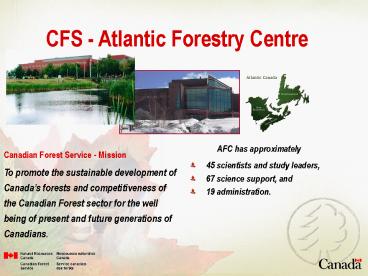Leaf - PowerPoint PPT Presentation
1 / 15
Title: Leaf
1
CFS - Atlantic Forestry Centre
AFC has approximately
Canadian Forest Service - Mission
- 45 scientists and study leaders,
- 67 science support, and
- 19 administration.
To promote the sustainable development of
Canadas forests and competitiveness of the
Canadian Forest sector for the well being of
present and future generations of Canadians.
2
Science Branch
CFS delivers research through a network of five
national target based areas.
- Climate change and fire research (NoFC Lead
Centre) - Enhanced timber production and protection
- Forest ecosystem processes
- Forest health and biodiversity (AFC Lead Centre)
- Knowledge and information synthesis
3
Presentation Outline
- AFCs Climate Change Program
- Research program initiated in 1991
- Current focus is on
- impacts and adaptation /modeling
- carbon accounting/mitigation
- Forest community
- Concluding remarks
- Resources Total establishment funding 17.1M.
- Climate Change Program 8 FTEs 0.5M/year in OM
funding, 40 of climate change staff and 60 of
funding is targeted to impacts and adaptation
4
Current Impacts and Adaptation Research
Assessing and Monitoring Change Impacts of
climate change on forest health and
productivity Variations in insect infestations
in the Maritime provinces and data base
development
5
Current Impacts and Adaptation Research
Remote Sensing Forest Growth/ Structure
1. Development of a spectral index of balsam fir
vigor
2. National strategy for biomass mapping in Canada
3. Methods for estimating and mapping forest
biomass
6
Current Impacts and Adaptation Research
Experimental Manipulations
- Will CO2 fertilization be limited by rising O3,
levels, nitrogen limitation or drought? - Yes, offset by O3
- No indication of N limitation after four years
- Evidence for water balance changes due to CO2 and
O3
- How will increasing CO2 affect insect and disease
interactions? - Effects of CO2 cascade through the system
- Changes mediated by bottom-up (plant) and
top-down (natural enemies) factors - Potential to alter insect community composition
7
Current Impacts and Adaptation Research
Mapping Historical Tree Decline (birch decline)
in relation to winter thaws.
Thaw frequency
Extent of Birch decline
Refreeze after 1945 April thaw
Developing risk assessments under climate change
scenarios.
8
Current Impacts and Adaptation Research
Winter thaws and the Birch decline model Frost
hardiness
Effects of thaw freeze physiological investigation
CONTROL
Model generation
THAW
9
Current Impacts and Adaptation Research
Spruce Genomics and adaptation to climate change
- Water relations
- Gas exchange
- Carbon isotope discrim.
- Freezing tolerance
- Nutrient relations
- Light use efficiency
Stress chambers
- Acadian Alternative Silviculture Project (CFS,
UNB, USDA, Dal. University)
10
Carbon Accounting/Mitigation
Fluxnet Canada
Measure exchanges of Carbon dioxide, heat and
water for mature and disturbed forest at sites in
important ecoregions across Canada.
New Brunswick site at Charles Lake
11
carbon accounting/mitigation
- 1. Feasibility Assessment of Afforestation for
Carbon Sequestration (FAACS) In partnership
with Nova Scotia Power Incorporated (NSPI). - Test the incentives and mechanisms necessary to
enable afforestation to be conducted on private
land.
- The Model Forest Network is working towards
developing and testing a generic carbon
accounting model in collaboration with the CFS
Carbon Accounting Team. - Promote the widespread application of that model
by forest managers and interested users across
Canada and internationally.
2.
12
Climate Impacts on Forest Communities
Major hurricane tracks across the Maritimes
Major Storm Blow-downs
Christmas Mountains 1994 gt30Million trees blown
down 100m 2,015,000 m3 of wood salvaged
3 years of allowable cut salvaged by all major
licensee's in New Brunswick
13
Concluding Remarks
- AFC has been conducting climate change research
since early 1990s - Changes in climate variability and seasonality
are expected to be more important to forest in
the east than increases in mean temperature. - Potential impacts include
- Changes in the distribution and levels of insect
populations and diseases - Changes/reductions in growth and yield
- Species shifting/extinction
- Increase in invasive and exotic species
14
Concluding Remarks
- Impact on forest sector
- Reduction in timber supply and changes to forest
practices - Influences on non-timber forest products and
services - Challenge the ability to conserve/manage
protected/wilderness areas - Subsequent impacts on viability of forest-based
communities - Research Thrusts
- Reducing uncertainty regarding future impacts
- Developing and testing adaptation and mitigation
strategies - Integrating biological/ecological and social
sciences
15
Questions discussion

